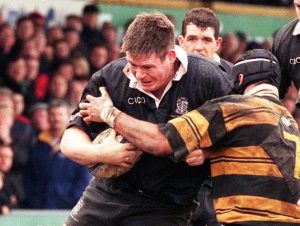Stuart Roy – the victim of “the punch from hell” who chose a very different path
Having suffered his fair share of misfortune during his own rugby career, Stuart Roy has spent the past 15 years helping hundreds of other players overcome theirs.
When you look back at his playing days, you have to wonder whether he might have walked under a few ladders or crossed the path of various black cats.
Not only was he on the receiving end of the ‘punch from hell’, but he also found himself caught up in the Battle of Brive, where he endured a spot of strangulation and a flying head-butt.

Straight after winning what was to be his solitary Wales cap, he ruptured knee ligaments, ruling him out of the rest of the 1995 World Cup. And then, three years later, he missed out on doubling his cap tally by a matter of seconds in a bizarre incident out in Dublin.
It’s some tale of bad luck, but, in contrast, he has turned around the fortunes of countless other players, getting them back out on the field through his work as an orthopaedic surgeon.
The former second row certainly has some stories to tell from his playing days, starting with the infamous ‘punch from hell’.
That was his legendary post-match description of the haymaker he received from Neath prop Brian Williams while playing for Cardiff at the Arms Park in September 1994.
“It was a pretty feisty affair with fights breaking out all over the place,” he recalls. “Gareth Llewellyn had a badly cut ear which needed stitching and Brian thought I was responsible for that.
“I wasn’t, as it happens, but I didn’t have time to explain that to him and, besides, I’m not completely sure he was open to reason at that point! He was incensed, thinking I had done something. So he came running in from 40 yards and caught me an absolute peach.
“That’s definitely the biggest punch I was ever on the receiving end of. He caught me good and proper, just above my eyebrow. It did hurt.”
Wales loosehead Williams was sent off, while Roy was left with seven stitches and a closed eye, which presented a significant problem as he was due to drive to Cambridge after the game for a medical exam the next morning.
Roy held no grudges with Williams, who sadly died at the age of just 46 in 2007.
“I got on really well with Brian and had huge respect for him,” he said.
“He was a terrific player with incredible strength and a superb level of fitness. He was such a genuine and honest man as well. Not long before he died, we had a good chat in the former players room. Both of us were able to agree rugby was a different sport in the 1990s.”
That was further illustrated by the infamous Battle of Brive in September 1997.
Roy had only recently joined Pontypridd from Cardiff when they headed out to the south of France for a Heineken Cup clash with the reigning European champions.
It was a day that was to go down in rugby folklore for both the on-field violence and the post-match bar brawl.
“That was only my second game for Ponty,” recalls Roy.“They were in their pomp at the time. I can remember the changing room that day. You just knew you were part of an outfit that wasn’t going to take a single step backwards.”
It wasn’t long before things turned ugly out on the pitch, with Roy the unfortunate victim of an assault from one of the Brive forwards.
“I caught the ball at the lineout and I think he was trying to get it off me,” he says.“He grabbed hold of my neck and just tried to strangle me.It did feel bad at the time, but watching it back on telly afterwards it looked terrible.
“It looked like he was trying to take my head off. I remember Huw Llywelyn Davies, the commentator, got very annoyed about it. It wasn’t long after that you had the big fight down in the bottom corner where it all erupted.”
Roy was to find himself in the firing line once again in the second-half when French international scrum-half Philippe Carbonneau picked him out for special treatment.
“I was pinned at the bottom of a ruck unable to move, with my head sticking out,” he said.“Carbonneau just did a flying head-butt and dropped his head onto me. I hadn’t done anything to upset him. It was all just happening in the match. He just saw an opportunity and took it.
“What made it worse was Brive scored a try from that passage of play. The touch judge put his flag up, but then he put it down. They shouldn’t have been given that try and, if they hadn’t, we would have won.
“Aside from all the things that happened, it was a hell of a game of rugby to play in. Then it all went wrong in the evening.”
Indeed it did, with players from both sides becoming embroiled in a huge brawl at Le Bar Toulzac.
“I was actually having a beer with my opposite number when the whole thing erupted,” reveals Roy.
“That certain part of the ethos wasn’t really my way, so a few of us left the bar and let everyone get on with it. It was absolute chaos. The police arrived, the tear-gas went in. I had moved to a pub just around the corner with some Ponty supporters. One by one, the boys were coming in with tears streaming down their face from the tear gas.
“The whole squad was put under hotel arrest and some players were kept in custody overnight. People talk about that game probably more than any other I was involved in. They go ‘you were in the Battle of Brive!’ It’s amazing.”
So, he was on the receiving end of the ‘punch from hell’ and found himself caught up in the punch-up from hell.
Does Roy ever wonder what he did to deserve it all?
“I don’t know why trouble kept following me around. I didn’t think I was disliked!” he replies.“You could understand it if I went looking for it, but I didn’t. I was just an innocent bystander.
“But I don’t hold any grudges. Things like that used to happen in those days.”
It seems misfortune might just run in the family when Roy explains how he ended up being born in Cambridgeshire.
“I was going to be born out in Singapore, which was where my dad was posted in the RAF,” he explains. “But he got poisoned by a stone fish while diving and went into renal failure. So he was rushed home by air ambulance and I was born in the RAF hospital in Ely on Christmas Day. I just tell people I was born in Ely. I don’t say anymore than that!”
Despite entering the world in England, Roy has very strong Welsh roots. His mum is a north Walian and he grew up on Anglesey, with his father being posted at RAF Valley.
After attending Ysgol David Hughes, he went on to study medicine at Bristol University and then do his masters at Hughes Hall, Cambridge, playing in the 1993 Varsity match.
There were representative honours for Wales Schoolboys and Welsh Students, with his fine form as an athletic second row for Cardiff seeing him selected for the 1995 World Cup in South Africa.
“I was a senior house officer doing my basic surgical training in the Royal Gwent at the time,” he recalls.
“I took unpaid leave to go to the World Cup. I remember being at the opening ceremony in Cape Town and looking at all these players I had been watching on telly over the years and thinking ‘God, I am actually here’.
“The whole experience as a young player was amazing.”
The fairytale continued when Roy was picked to make his Wales debut in the opening group match against Japan in Bloemfontein, which was won 57-10.
But then disaster struck.
“I got my cap and virtually my next training session I ruptured my ACL and my rugby world came crashing around my ears,” he says.“It was very disappointing.
“It’s maybe a reason why I do knee surgery now because I have got a lot of empathy for the guys that suffer that injury. It’a an absolute nightmare.”
There was to be a real twist of fate when Roy went in for his subsequent operation.
“I had it done by the surgeon who had been my examiner in Cambridge the day after that punch in the Neath game,” he reveals.“He said he remembered me coming in with a massive black eye!”
Roy fought his way back to fitness and in March 1998 he was named on the Wales bench for the Five Nations game against Ireland at Lansdowne Road.
It was to be a case of so near, yet so far.
“It was half-time and Andy Moore was in the treatment room, having stitches put in a cut,” he says.“I was out on the pitch warming up and the minutes were going by. The second half was about to begin and we all lined up in position as forwards.
“I was literally ready to receive the kick-off. Then, all of a sudden, Andy came running out of the tunnel. The shepherd’s crook came out and I was off.
“If only the surgeon had put one more suture in, I would have doubled my cap tally. But there we are. Certain people might argue technically it was a cap!”
After playing more than 150 games for Cardiff and having spells with Ponty and Newport, Roy hung up his boots at the age of 30 in 1999 to focus fully on his medical career.
Inspired in part by his own experience, he opted to train as an orthopaedic surgeon and for the last 15 years he has been a consultant, with a particular interest in sports injuries.
“There was certainly an empathy because of what I went through,” he says.
“That was definitely part of it. There is an affinity between rugby and orthopaedics and it’s a nice way of keeping in touch with the game.
“I have done thousands of knees over the years and plenty of rugby players, from weekend warriors to semi-pros. There are people you have done interviews with that I have done surgery on.
“It’s very satisfying to see people you have operated on running round a rugby pitch and there are plenty of them out there, still. I do knee reconstructive surgery, as in ligament repair, and for the older, more mature patients I do knee replacements as well.
“That’s my contact with former players. They come and hunt me out.”
A consultant trauma and orthopaedic surgeon, the 51-year-old father-of-three has an NHS practice at Royal Glamorgan Hospital in Llantrisant, while he does his private work in Spire.
“It’s a great career. I am very pleased that I did it,” he said. “My son is doing it now. I would highly recommend it to anyone.”























